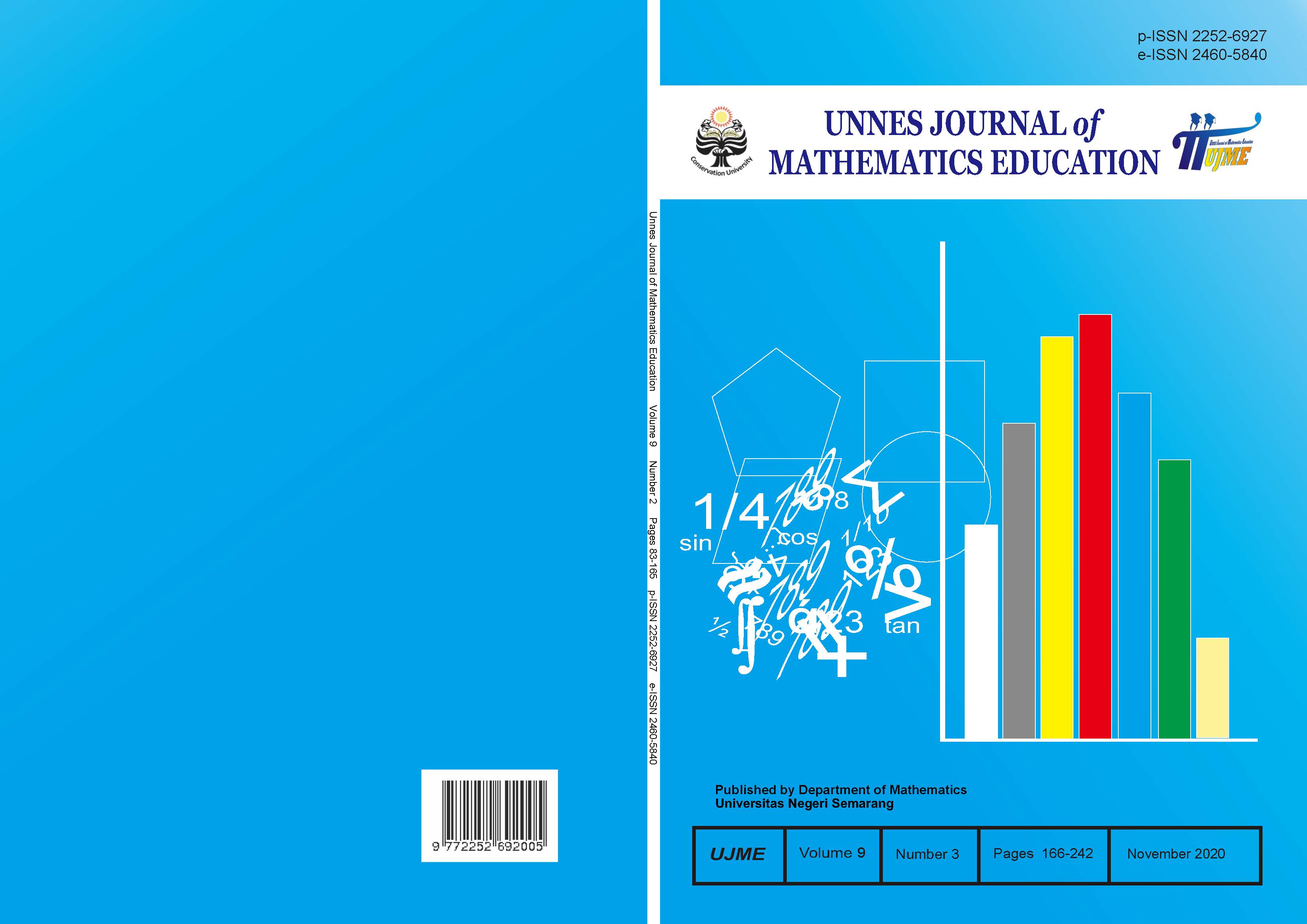The ability of mathematical representation on problem based learning of Krulik and Rudnick strategies
##plugins.themes.academic_pro.article.main##
Abstract
In learning mathematics, students still find it difficult to simplify a problem in the form of a problem description into a picture or symbol of mathematics correctly. This relates to students' mathematical representation ability which is still lacking and also its self efficacy. One effort to improve students' mathematical representation ability is through learning through the PBL model of Krulik and Rudnick's strategies. This study aims to examine the classical completeness of students in the aspects of mathematical representation ability, the average mathematical representation ability of students in the learning model Problem Based Learning of Krulik and Rudnick strategies and Problem Based Learning, and describe the ability of mathematical representation of students based on high self-efficacy, moderate, and low. This research uses a mixed method. The research class was taken by simple random sampling. The subjects of this study were 6 students of class VII A of SMP 1 Jambu who were selected by purposive sampling. Data collection using tests, questionnaires, and interviews. The results showed (1) The ability of mathematical representation with the Problem Based Learning model of the Krulik and Rudnick strategies achieving classical learning completeness; (2) The ability of mathematical representation of students in a class that uses Problem Based Learning Krulik and Rudnick strategies is better than the ability of mathematical representation of students in a class that uses Problem Based Learning; (3) Subjects with high self efficacy are able to meet all indicators of mathematical representation ability although there is still a lack of rigor in the work, subjects with moderate self efficacy are sufficiently able to meet the indicators of mathematical representation ability, while with low self efficacy there are still some indicators that have not yet been achieved namely indicators the ability of students to make mathematical equations or models from other given representations and write the steps for solving and solving mathematical problems correctly.
##plugins.themes.academic_pro.article.details##
References
Bandura, A. (1997). Self-efficacy: The Exercise of Control. New York: W.H. Freeman and Company.
Carson, J. (2007). A Problem With Problem Solving Teaching Thinking Without Teaching Knowladge. The Mathematics Educator, 17(2): 7-14.
Creswell, J. (2014). Research Design Pendekatan Metode Kualitatif, Kuantitatif, dan Campuran. Yogyakarta: Pustaka Pelajar.
Damaryanti, D. D., Mariani, S., & Mulyono. (2017). The Analysis of Geometrical Reasoning Ability Viewed from Self-Efficacy on Connected Mathematic Project (CMP) Learning Etnomathematics-Based. Unnes Journal of Mathematics Education, 6(3): 325–332.
Hamalik, O. (2011). Kurikulum dan Pembelajaran. Jakarta: Bumi Aksara.
Hamdiah, E., & Fajar, R. (2012). Teori-Teori Pembelajaran. Yogyakarta: Pustaka Pelajar.
Kurniati, L., & Utami, B.M. (2013). Pengaruh Metode Penemuan Strategi Heuristik Terhadap Kemampuan Berpikir Kritis Matematis. Himpunan Matematika Indonesia. 209.
Kusrianto, S.I., Suhito, & Wuryanto. (2016). Keefektifan Model Pembelajaran CORE Berbantuan Pop Up Book Terhadap Kemampuan Siswa Kelas VIII Pada Aspek Representasi Matematis. Unnes Journal of Mathematics Education, 5(2): 155-162.
Mareta, D. R., Yeni, & Kusumawati D. (2014). Pendekatan Hands On Activity Melalui Modified Inquiry Untuk Meningkatkan Self Efficacy Siswa Kelas XI SMA N 1 Tuban Pada Materi Pokok Laju Reaksi. Unesa Journal of Chemical Education, 3(1): 70-75.
Mardiyah, I., Suhito & Safaatullah, M. F. (2018). Analysis of Mathematical ReasoningAbility of Junior High School Students of Grade VII Viewed From Cognitive Style On Problem Based Learning With Mind Mapping. Unnes Jounal of Mathematics Education, 7(2): 122-128.
Masrukan. (2014). Asesmen Otentik Pembelajaran Matematika Mencangkup Asesmen Afektif dan Karakter. Semarang: Universitas Negeri Semarang.
Mogapi, M., Moalosi, W.T.S., & Tsheko, G. N. (2017). â€Self-Efficacy Factor Invariance Across Pre-Service and In-Service Teachers in Botswanaâ€. Asian Research Journal of Arts & Social Sciences, 4(4): 1-10.
Mulyono, Rahmawati, M. I., & Amidi. (2019). The Ability of Mathematical Problrm Solving Reviewed From Goal Orientation to Lerning Model of Problem Based Learning Asisted by Probem Card. Unnes Jounal of Mathematics Education, 8(1): 8-13.
Nadia, L. N., Waluyo, ST. B., Isnarto. (2017). Analisis Kemampuan Representasi Matematis Ditinjau dari Self Efficacy Siswa melalui Inductive Discovery Learning. Unnes Jounal of Mathematics Education Research, 6 (2): 242-250.
National Council of Teachers of Mathematics (NCTM). (2000). Principles and Standards for School Mathematics. Reston : The National Council of Teachers of Mathematics, Inc.
Ramziah, S. (2016). Peningkatan Kemampuan Representasi Matematis Siswa Kelas X_2 SMAN 1 Gedung Meneng Menggunakan Bahan Ajar Matriks Berbasis Pendekatan Saintifik. Jurnal Mosharafa, 5 (2): 138-147.
Sabirin, M. (2014). Representasi dalam Pembelajaran Matematika. Jurnal Pendidikan Matematika IAIN Antasari, 2: 33-44.
Saputro, D. A., Masrukan, & Agoestanto, A. (2017). Mathematical Communication Ability by Grade VII Students Using a Themed Problem Based Learning with Scaffolding on Rectangle Materials. Unnes Jounal of Mathematics Education, 6 (2): 239-248.
Sudjana, N. (2009). Penilaian Hasil Proses Belajar Mengajar. Bandung: PT Remaja Rosdakarya Offset.
Sugiyono. (2016). Metode Penelitian Kuantitatif, Kualitatif, dan Kombinasi (Mix Methods). Bandung: Alfabeta.
Tarmizi, M. A. A., Tarmizi, R. A., & Mokhtar, M. Z. B. (2010). Humanizing mathematics learning: Secondary students beliefs on mathematics teachers’ teaching efficacy. Procedia-Social and Behavioral Sciences, 8: 532-536.
